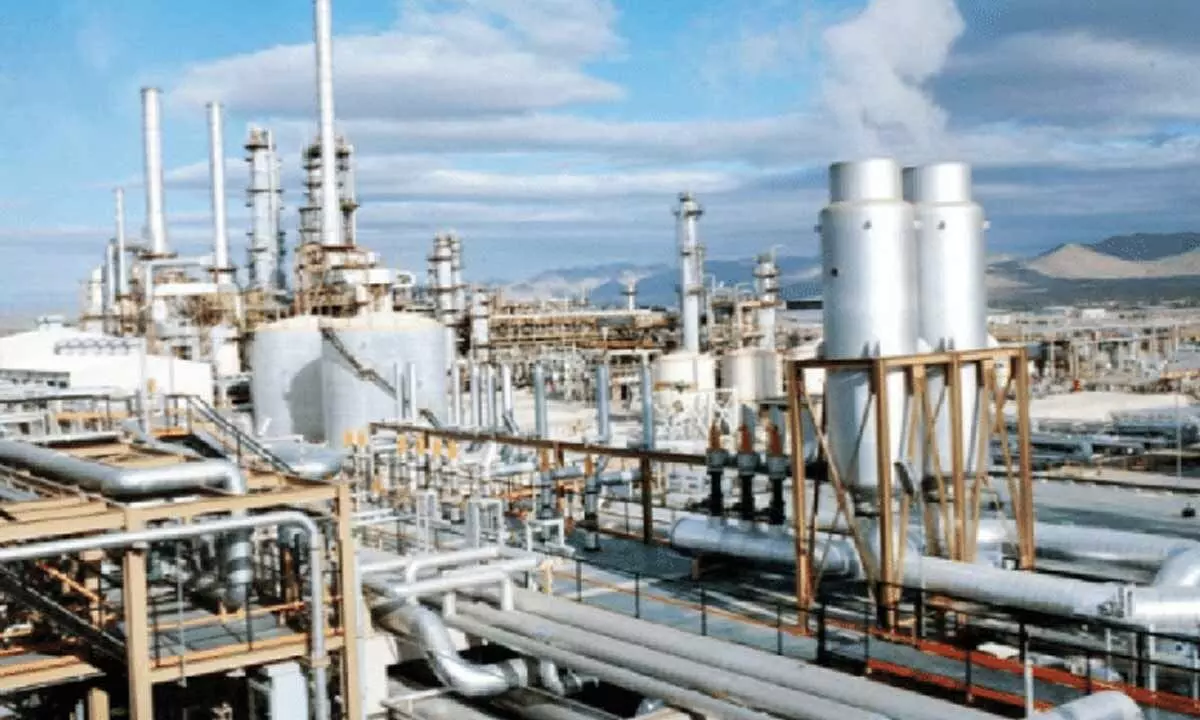Despite headwinds, India's petrochemical market in growth trajectory
Petrochemicals sector may reach $300-bn mark in 2025 from $178 bln in the year 2020
image for illustrative purpose

Hyderabad: Petrochemicals sector in India has been rapidly growing and playing a key role in GDP growth. With consumption of 4.5 lakh barrels per day, India emerges as world's third largest oil consumer after the US and China, and followed by Japan. The petrochemical market in India stood at 42.50 million tons (MT) and is estimated to reach 49.62 MT by 2025 as it's growing at a compound annual growth rate (CAGR) of 6.20 per cent.
Today the Indian economy a $2.7 trillion and the Centre has set a target of $5trn economy by 2024-25. The manufacturing sector alone would contribute $1 trn to the $5-trn economy. The petrochemicals segment accounts for six per cent in Indian manufacturing industry. Considering that same share is maintained in reaching the $5-trn market, then the petrochemical sector needs to grow at 15% per annum till 2024-25 fiscal. The petrochemicals segment accounts for over a third of the growth in oil demand to 2030, and nearly half to 2050, ahead of trucks, aviation and shipping.
However, the emergence of electric vehicle (EV) which may drastically change the fuel demand would give rise to altogether new concept of Oil-to-Chemicals for the industry.
The penetration level of petrochemicals in India is still lower than the global average. Per capita consumption in India stands at 10kg compared to the global average of 30kg. This huge gap is showing the broad-based growth and significant headroom for the petrochemicals industry.
The petrochemicals sector is the backbone for the development of several key sectors such as agriculture, infrastructure, health care, automobile, textiles and consumer durables. The key application industries like packaging, construction, and automobiles pulled down the demand, after which the industry faced turmoil of Covid which has impacted demand across sectors with factory closures and lockdown situation impacting supply chains in 2019-20 financial year, according to CPMA.
Petrochemicals
Chemicals and Petrochemicals Manufacturers' Association (CPMA) forecasts that India petrochemical demand returned to pre-pandemic level and is poised to grow further. Industry analysts observed that there would be moderate impact of the previous year's sharp economic slowdown and ongoing Russia-Ukraine war. "Owing to end-market diversity and exposure to more resilient sectors, the impact of an economic recession on petrochemicals was moderate in the last one year as compared with other industries. In the previous fiscal year ending March 2021, major commodity polymers – polypropylene (PP) and polyethylene (PE) – have performed well. Demand (for PP and PE) remained at the same level as that in 2019-20. However, the demand for fibre intermediates got affected by around 20 per cent, which has been rebounding to 2019 levels in the current financial year," said Mahinder Singh, secretary general, CPMA.
It's estimated that in late April and early May, at the height of the second wave of Covid-19 infections in India, run rates across most Indian polyester producers had dropped by nearly 30 per cent to around 50 per cent.
At the time, various forms of lockdowns had been in place across different states to stem the deadly contagion.
"After a brief pause in April-May this year, petrochemical demand has resumed its upward trend in June 2021 and petrochemical capacity is likely to be revived in the near future. Recent spikes in fuel prices, however, have pushed up the cost of transportation from manufacturers to downstream players," Singh said.
Auto fuel prices in India have been surging since May and have now crossed a record high of Indian rupees Rs100/litre ($1.34/litre) across the country.
Brent crude oil prices went over $130 per barrel in the early hours of Monday, surpassing the top 2012 mark of over $128. The Brent price reached a historical maximum in 2008 when it stood at over $143 per barrel. The price of May futures for Brent around $130.13 per barrel, a 13-year high recorded in March 2022. Brent crude tested $139.13 at one point of time during the month.
Russia-Ukraine War Impact
Eastern Europe has been suffering from one of the worst security crises in decades. The Russia-Ukraine conflict has already triggered a rally in crude oil and gas markets as well as a big dose of uncertainty, adding to the already high inflationary pressure on global commodity markets. PE makes up half of Russia's overall polymer exports while PP stands for 30%. Their major destination is China for PE and Turkey for PP. As for PE, %50 of their export is to China, 9% to Kazakhstan and 4% to Turkey. Regarding PP, Turkey has a 23% share, standing at the top of the list. Poland and Belarus followed with respective shares of 15% and 12%.
Russia is expected to sustain its exports to China and Turkey. However, some market share is lost in sales to Eastern Europe. Some even opine that Russian PP and PE may show up in these regions at competitive prices in case of stock pressure amidst narrower alternatives for exports.

